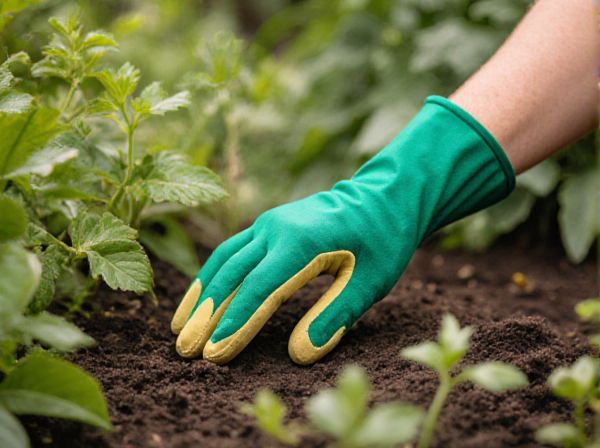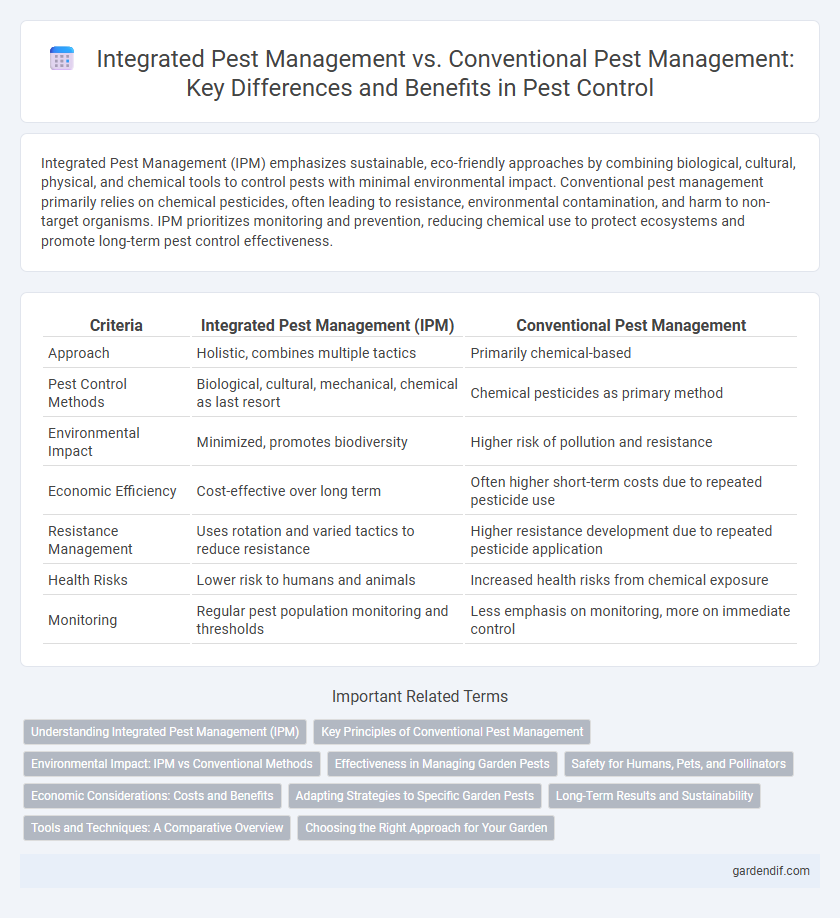
Integrated Pest Management vs conventional pest management Illustration
Integrated Pest Management (IPM) emphasizes sustainable, eco-friendly approaches by combining biological, cultural, physical, and chemical tools to control pests with minimal environmental impact. Conventional pest management primarily relies on chemical pesticides, often leading to resistance, environmental contamination, and harm to non-target organisms. IPM prioritizes monitoring and prevention, reducing chemical use to protect ecosystems and promote long-term pest control effectiveness.
Table of Comparison
| Criteria | Integrated Pest Management (IPM) | Conventional Pest Management |
|---|---|---|
| Approach | Holistic, combines multiple tactics | Primarily chemical-based |
| Pest Control Methods | Biological, cultural, mechanical, chemical as last resort | Chemical pesticides as primary method |
| Environmental Impact | Minimized, promotes biodiversity | Higher risk of pollution and resistance |
| Economic Efficiency | Cost-effective over long term | Often higher short-term costs due to repeated pesticide use |
| Resistance Management | Uses rotation and varied tactics to reduce resistance | Higher resistance development due to repeated pesticide application |
| Health Risks | Lower risk to humans and animals | Increased health risks from chemical exposure |
| Monitoring | Regular pest population monitoring and thresholds | Less emphasis on monitoring, more on immediate control |
Understanding Integrated Pest Management (IPM)
Integrated Pest Management (IPM) is an eco-friendly pest control strategy that combines biological, cultural, physical, and chemical tools to minimize pest damage while reducing environmental impact. Unlike conventional pest management, which relies heavily on chemical pesticides, IPM emphasizes pest prevention, monitoring, and the use of natural predators to maintain pest populations below harmful levels. This approach promotes sustainable agriculture by enhancing crop health and reducing pesticide resistance.
Key Principles of Conventional Pest Management
Conventional pest management primarily relies on the application of chemical pesticides to control pest populations rapidly and effectively. It emphasizes routine pesticide use, targeting specific pests with synthetic insecticides, herbicides, and fungicides to protect crops. This approach often lacks consideration for environmental impact and pest resistance, focusing instead on immediate pest eradication.
Environmental Impact: IPM vs Conventional Methods
Integrated Pest Management (IPM) minimizes environmental impact by using targeted biological controls, monitoring, and habitat manipulation to reduce pesticide reliance. Conventional pest management often relies heavily on broad-spectrum chemical pesticides, leading to soil degradation, water contamination, and harm to non-target species. Adopting IPM practices promotes biodiversity and sustainability, significantly lowering ecological disturbances compared to conventional methods.
Effectiveness in Managing Garden Pests
Integrated Pest Management (IPM) employs biological controls, cultural practices, and targeted chemical use, resulting in more sustainable and effective garden pest control compared to conventional methods. Conventional pest management often relies heavily on broad-spectrum chemical pesticides, which can lead to pest resistance and environmental harm. IPM's strategic approach reduces pest populations while preserving beneficial insects and minimizing chemical residues, enhancing long-term garden health.
Safety for Humans, Pets, and Pollinators
Integrated Pest Management (IPM) prioritizes safety by using targeted, low-toxicity methods that minimize harm to humans, pets, and pollinators, reducing chemical exposure and environmental impact. Conventional pest management often relies on broad-spectrum pesticides that pose higher risks of toxicity and unintended harm to beneficial species like bees and butterflies. IPM strategies incorporate biological controls, habitat manipulation, and careful monitoring to maintain ecological balance while effectively managing pest populations.
Economic Considerations: Costs and Benefits
Integrated Pest Management (IPM) reduces long-term costs by minimizing pesticide use, lowering environmental cleanup expenses, and enhancing crop yields through targeted pest control strategies. Conventional pest management often incurs higher immediate expenses due to frequent chemical applications, increased resistance development, and potential regulatory penalties. Economic benefits of IPM include improved sustainability, decreased input costs, and preservation of beneficial organisms, leading to greater profitability for farmers over time.
Adapting Strategies to Specific Garden Pests
Integrated Pest Management (IPM) tailors control methods for specific garden pests by combining biological, cultural, and mechanical tactics, reducing reliance on chemical pesticides and minimizing ecological impact. Conventional pest management often applies broad-spectrum pesticides uniformly, which can lead to pest resistance and harm beneficial organisms. Adapting strategies in IPM involves monitoring pest populations, identifying pest species accurately, and selecting targeted interventions that preserve garden health and biodiversity.
Long-Term Results and Sustainability
Integrated Pest Management (IPM) offers long-term pest control solutions by combining biological, cultural, mechanical, and chemical methods that reduce pest resistance and environmental impact. Conventional pest management often relies on repeated chemical pesticide applications, which can lead to pesticide resistance, non-target species harm, and ecological imbalance. Sustainable pest control through IPM enhances soil health, promotes biodiversity, and supports ecosystem resilience, ensuring effective pest suppression over time.
Tools and Techniques: A Comparative Overview
Integrated Pest Management (IPM) utilizes a combination of biological controls, cultural practices, and selective chemical applications to minimize pest damage while reducing environmental impact. Conventional pest management relies heavily on broad-spectrum chemical pesticides for immediate pest eradication, often leading to resistance and ecological imbalance. IPM tools emphasize monitoring, pest identification, and threshold-based interventions, contrasting with the conventional approach's frequent and preventive pesticide usage.
Choosing the Right Approach for Your Garden
Integrated Pest Management (IPM) prioritizes sustainable methods like biological control, monitoring, and targeted pesticide use to minimize environmental impact and enhance long-term pest control effectiveness. Conventional pest management often relies on broad-spectrum chemical pesticides, which can lead to pesticide resistance, non-target species harm, and ecosystem disruption. Selecting IPM for your garden supports healthier soil, beneficial insect populations, and reduces chemical residues, promoting a balanced and resilient growing environment.
Integrated Pest Management vs conventional pest management Infographic

 gardendif.com
gardendif.com